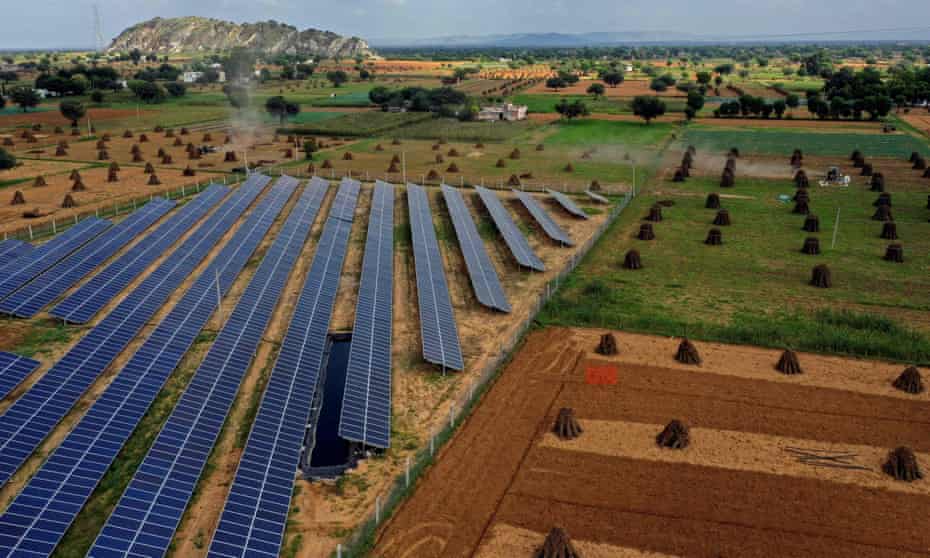World leaders announce plan to make green tech cheaper than alternatives
UK, US and China among countries representing two-thirds of global economy to agree to push green energy and cars

A plan to coordinate the global introduction of clean technologies in order to rapidly drive down their cost has been agreed at the Cop26 summit by world leaders representing two-thirds of the world’s economy.
A global transition to green energy and vehicles is vital in tackling the climate crisis, and economies of scale mean that costs plummet as production increases – as already seen with solar panels and LED lightbulbs.
More than 40 nations said they would align standards and coordinate investments to speed up production and bring forward the “tipping point” at which green technologies are more affordable and accessible than fossil-fuelled alternatives. At that point, the green transition and cuts in climate emissions accelerate rapidly towards a net zero economy.
Among the countries signed up to the Breakthrough Agenda are the UK, US, China, India, the EU and Australia. The first five breakthroughs will be clean electricity, electric vehicles, green steel, hydrogen and sustainable farming. The aim is to make these affordable and available to all nations by 2030 and create 20m new jobs.
“By making clean technology the most affordable, accessible and attractive choice, the default go-to in what are currently the most polluting sectors, we can cut emissions right around the world,” said Boris Johnson, prime minister of the UK, which is hosting Cop26.
“The Glasgow Breakthroughs will turbocharge this forward, so that by 2030 clean technologies can be enjoyed everywhere, not only reducing emissions but also creating more jobs and greater prosperity,” said Johnson, who launched a GBP3bn finance package on Monday to support green technology in developing countries.
New plans include a global electricity initiative launched by the UK and India and endorsed by 80 nations. The Green Grids Initiative aims to mobilise political will and finance to create international supergrids on all continents and to link up sunny deserts and windy coasts with population centres. By connecting many locations, supergrids are key to providing reliable electricity from renewable energy that may be locally intermittent.
Another new initiative is the Global Energy Alliance for People & Planet, which is focused on producing clean electricity across the global south. It has an initial $10bn from the World Bank, Rockefeller Foundation, Bezos Earth Fund and others. UK and Scandinavian pension funds also announced on Tuesday they would invest $130bn in clean energy by 2030.
The authors of a report published to support the Breakthrough Agenda concluded: “International collaboration can create faster innovations, larger economies of scale, and stronger incentives for investment, to accelerate progress towards tipping points where clean solutions become the most affordable, accessible and attractive options worldwide.”
The Breakthrough Agenda follows other voluntary agreements at Cop26 on ending deforestation by 2030 and cutting global emissions of methane, a potent greenhouse gas, by 30%. These commitments have been broadly welcomed, but some delegates warned that global heating would not be reduced unless the plans become reality. Nations at the two-week summit are also tasked with getting funding to poorer and vulnerable countries and finalising the rules of the 2015 Paris agreement.
The cost of solar panels, LED bulbs and lithium ion batteries have plunged by about 90% in the past decade, with solar and wind power now the cheapest power in most of the world. By coordinating signals to industry, policies and standards, research efforts and investments, the governments aim to drive production up and prices down for other technologies.
Electric cars are already cheaper to run than those burning fossil fuels and are close to the tipping point when they become cheaper to buy. Requiring carmakers across big markets to make a certain proportion of new cars electric, for example, could increase this.
The nations will coordinate to speed up the growth of markets, but will also compete to supply those markets. A recent study from Oxford University estimated the costs of clean energy technologies such as batteries and hydrogen electrolysers could fall by 45% by 2030 and 75% by 2050 with speedy deployment.
The private sector is involved in the Breakthrough Agenda with a “first movers coalition” of 25 global companies committing to buy emerging clean technologies in sectors such as steel, trucking, shipping, aviation and concrete. Firms are expected to include the shipping company Maersk and the cement maker Holcim.
In farming, coordinated rules for blocking imports of beef, soy, palm and cocoa linked to deforestation could hasten the end of forest destruction. A US-UAE initiative, backed by 30 countries, has gathered $4bn (GBP2.9bn) for investment in climate-smart agriculture.
World leaders have committed to discussing and strengthening global progress on breakthroughs every year, supported by reports led by the International Energy Agency.
The Economics of Energy Innovation and System Transition report was produced by experts from the UK, EU, Brazil, China, and India. “The policies that drove major breakthroughs in low-carbon technologies like wind and solar, were challenged by traditional economic advice, which ignored the role of innovation [in reducing costs] and framed climate policy as costly,” said Prof Michael Grubb, at University College London and a co-author of the report. “We need to learn from these successes.”
Prof Nicholas Stern, at the London School of Economics, said last week that most economists had badly underestimated the speed at which the costs of clean technologies fall and failed to take account of the “immense risks and potential loss of life” that could occur as a result of the climate crisis.
